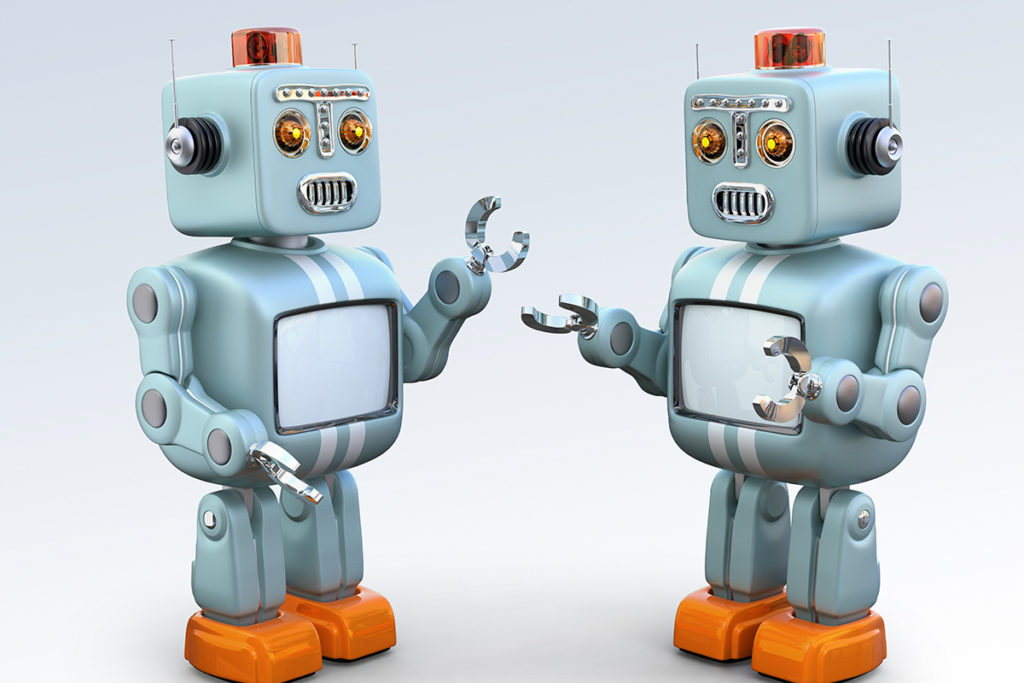Robots!
See below for robot books and resources of all kinds. Build a robotic arm and a programmable robot; make tin-can and cereal-box robots; and learn about a robot so adorable that people help it cross the street.
Table of Contents
READ ABOUT ROBOTS – Fiction
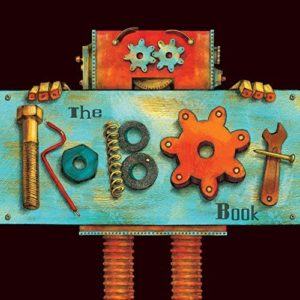 |
Heather Brown’s The Robot Book (Accord Publishing, 2013) explains what a robot is made of – one mouth, two eyes, two arms – but it’s what’s inside (a mechanical heart) that counts. A great interactive book with sturdy cogs, gears, bolts, and wheels to turn, slide, and manipulate. For roboticists ages 1-4. |
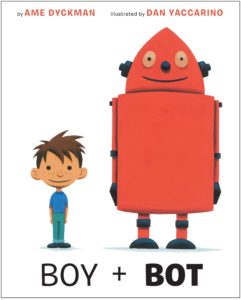 |
In Ame Dyckman’s Boy and Bot (Knopf Books for Young Readers, 2012), a boy out gathering pine cones meets a big bright-red soup-can-shaped robot in the woods and the two have a wonderful time playing – until the robot’s power switch is inadvertently switched off. Worried, the boy takes the robot home and does everything he can think of to revive it, including reading it a story and feeding it applesauce. Finally the boy falls asleep. The robot then powers on, only to find his new friend – off. He carries the boy back to the laboratory and attempts to repair the malfunction (oil? a new battery?). Luckily all is put right by the timely arrival of the robot’s inventor. Cleverly funny, with a simple text for ages 3-6. |
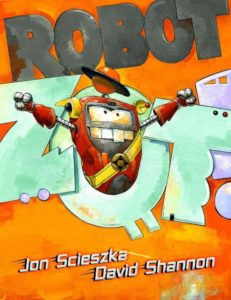 |
Jon Scieszka’s Robot Zot! (Simon & Schuster, 2009) is out to conquer the Earth. The problem: he has landed in a household kitchen and he’s just three inches tall. He battles enemy kitchen appliances and a television set, and rescues the Queen of All Earth (a pink cell phone), before speeding off to conquer new galaxies. The pictures are hilarious, and so is Robot Zot, who talks like the Terminator. (“No one stop Robot Zot. Robot Zot crush lot.”) For ages 3-7. |
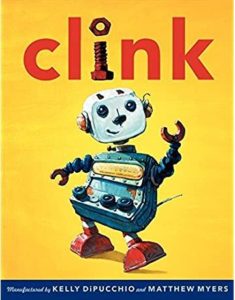 |
The star of Kelly DiPucchio’s Clink (Balzer + Bray, 2011) is an outmoded little robot with red feet, who can make (burned) toast and play music, but lacks the glitzier features of the newer, spiffier robots. Eventually, however, a little boy comes along for whom Clink is just right. It’s a Corduroy story, with robots. For ages 4-7. |
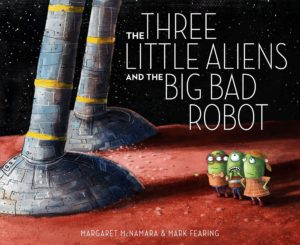 |
In Margaret McNamara’s The Three Little Aliens and the Big Bad Robot (Schwartz & Wade, 2011), an outer-space take on the Three Little Pigs tale, the three little (green) aliens, Bork, Gork, and Nklxwcyz, have been sent off by their mama to find planets of their own – but have been told to beware of the Big Bad Robot. (“I’ll crack and smack and whack your house down!” meeped the Robot.) For ages 4-8. |
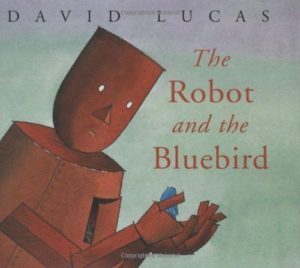 |
David Lucas’s The Robot and the Bluebird (Farrar, Straus & Giroux, 2008) is an old-fashioned fable (with robot). A robot with a broken heart is sent to the scrap heap where, one cold night, he adopts a shivering little bluebird. The bird makes her home in the robot’s empty chest and when she explains that she needs to travel south for the winter, he sets out to take her there. The robot gives out when they arrive, with the last words “Make your home in my heart” – and he ends up as a home for generations of nesting bluebirds. For ages 4-8. |
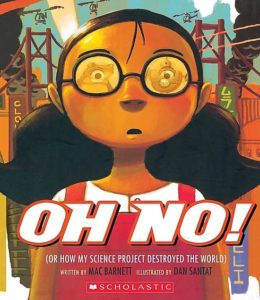 |
In Mac Barnett’s Oh No! Or How My Science Project Destroyed the World (Disney Hyperion, 2010) – a picture book in graphic novel format – a little girl builds a gigantic robot for the science fair. The robot promptly breaks loose and goes on a rampage through the city. (“I probably shouldn’t have given it a superclaw or a laser eye or the power to control dogs’ minds,” she opines.) Funny and clever. For ages 4-9. |
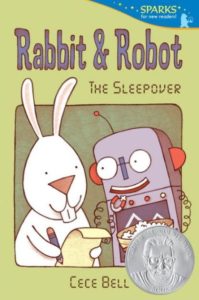 |
In Cece Bell’s Rabbit and Robot (Candlewick, 2014), Robot spends the night with his friend Rabbit. Rabbit has a list of activities planned, but everything soon goes wrong – beginning with the pizza. (Robot doesn’t like carrots on his; he prefers nuts and bolts.) And there’s a great scene is which both appear in Rabbit-shaped pajamas. For early readers ages 5-7. |
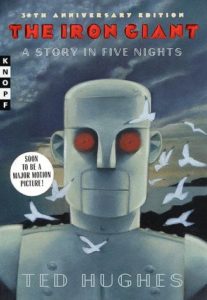 |
In poet Ted Hughes’s The Iron Giant (Yearling, 1999), an enormous and indestructible robot with glowing eyes has crashed to Earth and is feeding himself on metal: barbed wire, tractors, and farm equipment. A little boy named Hogarth befriends the Giant and turns to him when a mysterious alien creature – the Space-Bat-Angel-Dragon – lands in Australia. As it turns out, the space creature is really there to bring about world peace. For ages 6-9. |
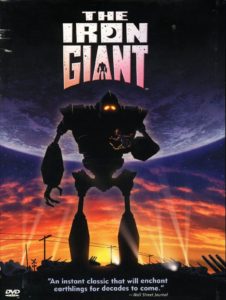 |
The 1999 film version of The Iron Giant is rated PG. |
| From Wired magazine, a thought-provoking article on The Iron Giant. | |
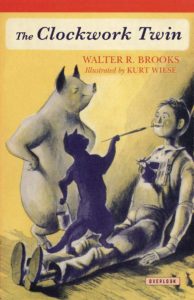 |
For fans of the irrepressible and imaginative Freddy the Pig, see Walter R. Brooks’s The Clockwork Twin (Overlook Juvenile Books, 2013), in which Freddy and fellow animals on the Bean farm rescue a boy named Adoniram Smith from both a flood and his cruel aunt and uncle. Realizing that the boy is lonely, they convince Mr. Bean’s inventor brother Benjamin to make him a friend: a wooden robot operated by clockwork. When the aunt and uncle show up to reclaim Adoniram, they mistake the clockwork twin for the real boy. As always, Freddy and friends are funny, flamboyant, and make for a great read. For ages 7-10. |
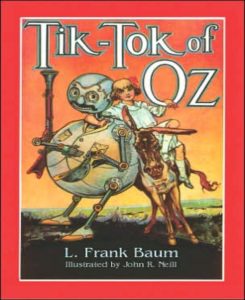 |
Vintage robot! L. Frank Baum’s Tik-Tok of Oz (HarperCollins, 1996) – eighth book in the original Oz series – features Tik-Tok, a clockwork man, and Betsy Bobbin of Oklahoma, who ends up in Oz along with her friend Hank, a mule. For ages 7-11. |
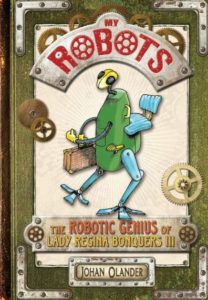 |
John Olander’s steampunk-ish My Robots (Two Lions, 2012) purports to be notes on the robots made by genius inventor Lady Regina Bonquers III (who disappeared in 1972). The book is designed like a scrapbook, crammed with photos, notes, sketches, newspaper clippings, and souvenirs. A fun read for ages 8-12. |
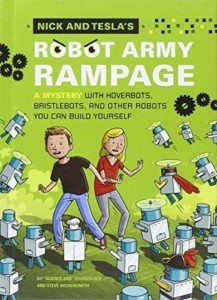 |
By Bob Pflugfelder and Steve Hockensmith, Nick and Tesla’s Robot Army Rampage (Quirk Books, 2014) features Nick and Tesla, 11-year-old sleuths who solve mysteries using science. In this book – one of a series – they nab a criminal mastermind using robots. Instructions for building four different robots are included in the book, among them the Semi-Invisible Bottle Bot, for which you’ll need (among other things) two wire coat hangers and a 2-liter plastic water bottle. For ages 8-12. |
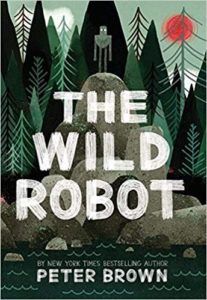 |
In Peter Brown’s The Wild Robot (Little, Brown, 2016), the robot – Roz (short for ROZZUM unit 7134) has ended up on an island, where she is inadvertently activated by a bunch of sea otters. As Roz struggles to survive, she learns to cope with her new environment and gradually to become part of the animal community. For ages 8-12. |
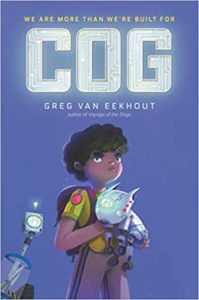 |
The star of Greg van Eekhout’s Cog (HarperCollins, 2019) looks like a 12-year-old boy but is actually a robot – his name, Cog, is short for “cognitive development.” Separated from his kind scientist caretaker, Gina, by the unscrupulous uniMIND corporation, who plans to use him for experiments, Cog escapes and sets off to find Gina, along with four robot accomplices, including his sister ADA (a weapon android). A thought-provoking story of what it means to be human for ages 8-12. |
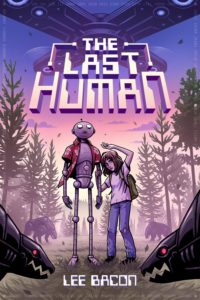 |
In Lee Bacon’s The Last Human (Harry N. Abrams, 2019), humans have been eliminated from the planet and robots have established a society of their own. Then XR-935, whose purpose in life is to install solar panels, meets a 12-year-old human, Emma, looking for help for her dying family and friends in their hidden bunker. In company with two robot companions – enormous Ceeron and zippy SkD, who communicates via emoji pictures – Emma and XR_935 set off on a dangerous journey, discovering much along the way about friendship and tolerance. For ages 9-12. |
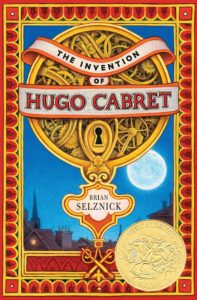 |
Brian Selznick’s The Invention of Hugo Cabret (Scholastic, 2007) features 12-year-old Hugo, an orphan who lives secretly in the Paris train station, an incredible automaton in the form of a writing man, and Georges Melies, a master of early silent film. A terrific read for ages 9-12. |
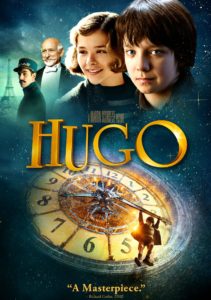 |
Hugo, the 2011 film version of the book, was directed by Martin Scorsese. Rated PG. |
 |
Selznick’s automaton is based on The Writer, an automaton built by Pierre Jaquet-Droz in the late 1770’s and believed to be the oldest example of a computer. |
| A similar automaton, Maillardet’s Draughtsman-Writer, dates to the same period. It is now in the Franklin Institute science museum in Philadelphia. | |
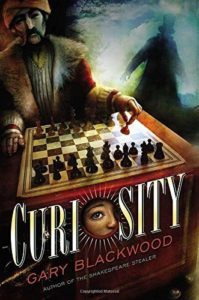 |
Gary Blackwood’s The Curiosity (Dial, 2014) is the story of Rufus, a 12-year-old chess prodigy, recruited by a sleazy showman to operate a chess-playing automaton called the Turk. History, mystery, and suspense for ages 9-12. |
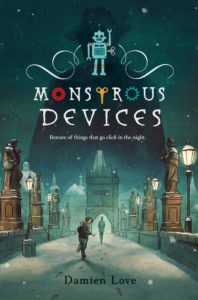 |
In Damien Love’s Monstrous Devices (Viking, 2018), young Alex is given an old tin robot by his grandfather, with a note reading “This one is special.” Soon Alex and his grandfather end up fleeing across Europe, pursued by dangerous people and animated robots. An exciting adventure for ages 9-12. |
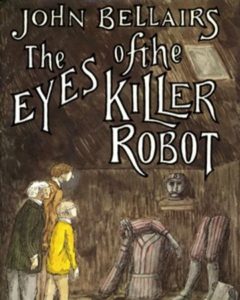 |
John Bellairs’s books are Gothic novels for kids: creepy, dark, and exciting. In The Eyes of the Killer Robot (Bantam, 1994), starring Johnny Dixon, evil wizard Evaristus Sloane plans to bring a robot to life – using Johnny’s eyes. Available for Kindle and at libraries. (If you get hooked, all the Bellairs books are available for Kindle. The series was continued by Brad Strickland after Bellairs’s death.) For ages 9-12. |
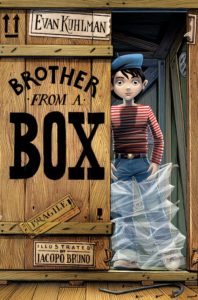 |
In Evan Kuhlman’s Brother from a Box (Atheneum, 2013), Matt’s “brother” is a French robot named Norman, created by his genius computer scientist father. There’s humor and suspense – Norman catches a computer virus and goes nuts; a pair of sinister strangers attempt to steal him – but there’s food for thought here too. Matt, for example, discovers that Norman resembles a son his parents lost years ago. For ages 9-12. |
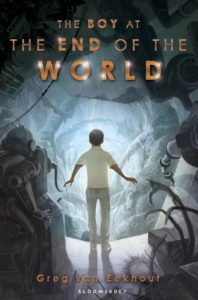 |
In Greg van Eekhout’s post-apocalyptic The Boy at the End of the World (Bloomsbury USA, 2012), Fisher – who may be the last living person on Earth – sets off on a quest with Click, the robot, a pygmy mammoth, and a talking prairie dog to find others of his kind. For ages 10 and up. |
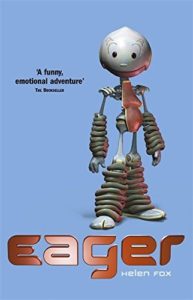 |
In Helen Fox’s Eager (Yearling, 2006), set in a high-tech future England, Grumps, the old-fashioned robot belonging to Gavin and Fleur Bell’s family, is running down, and they can’t afford one of the new state-of-the-art BDC4s. A helpful scientist friend then loans them EGR3, known as Eager, an unusual little robot who is able to learn and feel emotions like a human child. Together, the children and Eager uncover a plot by the sinister BDC4 robots to rebel against their owners and take over the world. The book raises questions about what it means to be human and the dangers of technology. A discussion promoter for ages 11-14. |
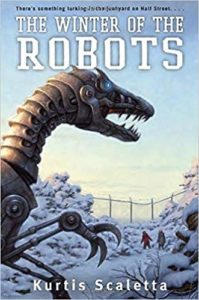 |
In Kurtis Scaletta’s The Winter of the Robots (Knopf Books for Young Readers, 2013), set in Minneapolis, Jim – the narrator – sick of playing second fiddle to his science geek friend Oliver, has decided to partner for the science fair with Rocky, a girl who wants to study otters. Then, along with Oliver and his new science partner, Dmitri, the kids begin to investigate a peculiar junkyard (on the site of a former research company) and discover a population of fierce feral self-programming robots. To combat these, the kids create battle bots of their own. An exciting read for ages 11-14. |
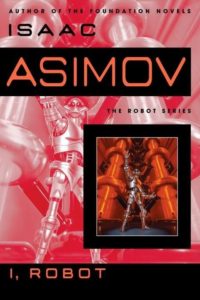 |
Isaac Asimov’s I, Robot (Spectra, 2008) introduces the famous “Three Laws of Robotics:” (1) A robot may not injure a human being or, through inaction, allow a human to come to harm. (2) A robot must obey orders give to it by humans except where such orders conflict with the First Law. (3) A robot must protect its own existence as along as such protection does not conflict with the First or Second Law. He follows up with a terrific series of interlinked robot stories. Two sequels. Highly recommended for ages 12 and up. |
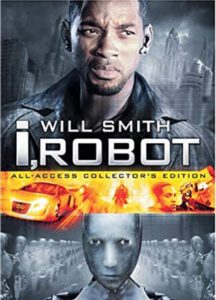 |
The 2004 film I, Robot is sort of based on parts of the book. Rated PG-13. |
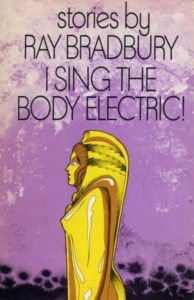 |
The title story of Ray Bradbury’s short-story collection I Sing the Body Electric! (William Morrow, 1998) is a tale of how a robotic grandmother comes to comfort a family of grieving children. It’s a lovely story and if you can track down the 1982 television movie version – The Electric Grandmother starring Maureen Stapleton – even better. |
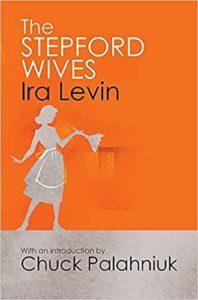 |
In Ira Levin’s The Stepford Wives (William Morrow, 2002), protagonist Joanna and family move to the little town of Stepford where she soon notices that all the women are turning into gorgeous and submissive housewives. Feminist issues and robots. A cool read for ages 13 and up. |
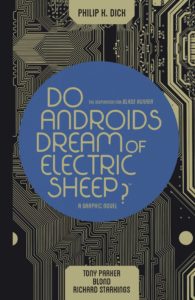 |
In Philip K. Dick’s dystopic post-World-War-Terminus sci-fi novel Do Androids Dream of Electric Sheep? (Del Ray, 1996), Rick Deckard, the main character, is a bounty hunter, tracking androids – which is difficult, because the androids are nearly impossible to tell from human beings. (The crucial difference: androids lack empathy.) Decakard is also broke, and can’t afford an organic pet – the ultimate in status symbols. Instead he owns an electric sheep. A thought-provoking read for ages 13 and up. |
| The 1982 film Blade Runner is loosely (very loosely) based on the PKD’s book. Harrison Ford plays Rick Deckard. Rated R (for violence). | |
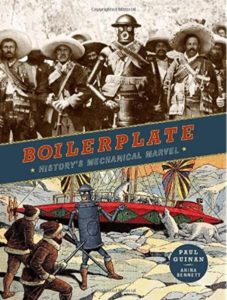 |
First, THIS IS NOT REAL, even though it looks real. A robot named Boilerplate did not charge up San Juan Hill with the Rough Riders or visit the South Pole. Paul Guinan and Anina Bennett’s Boilerplate (Harry N. Abrams, 2009) purports to be the story of “History’s Mechanical Marvel” – a robot soldier named Boilerplate, invented in 1893, and subsequently sharing the stage with everyone from Teddy Roosevelt to Lawrence of Arabia. Wonderful creative graphics (and a testimony to Photoshop). For teens and adults.
See more on Boilerplate here. |
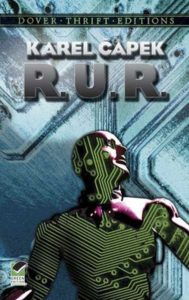 |
Karel Capek’s R.U.R. (Penguin Classics, 2004) is the science fiction play, originally written in 1920, that first introduced the word “robot.” The initials stand for Rossum’s Universal Robots, a robot-making factory. Issues of justice, power, and the effect of advanced technology on humanity. For ages 13 and up. |
| Read R.U.R. online here. |
